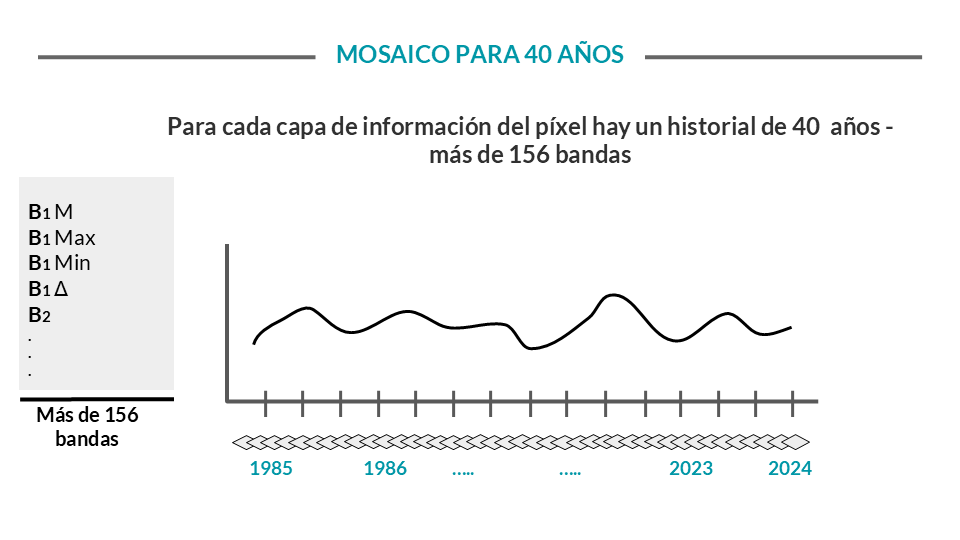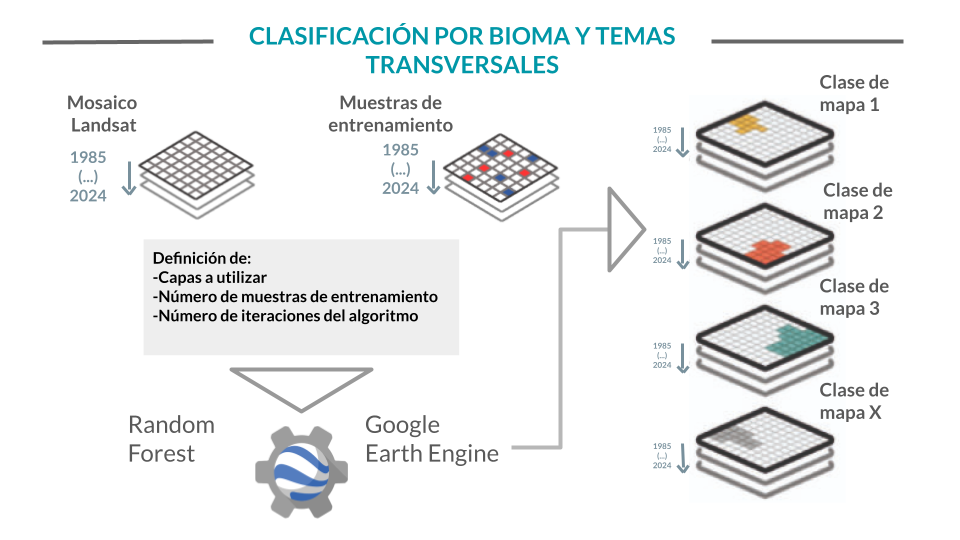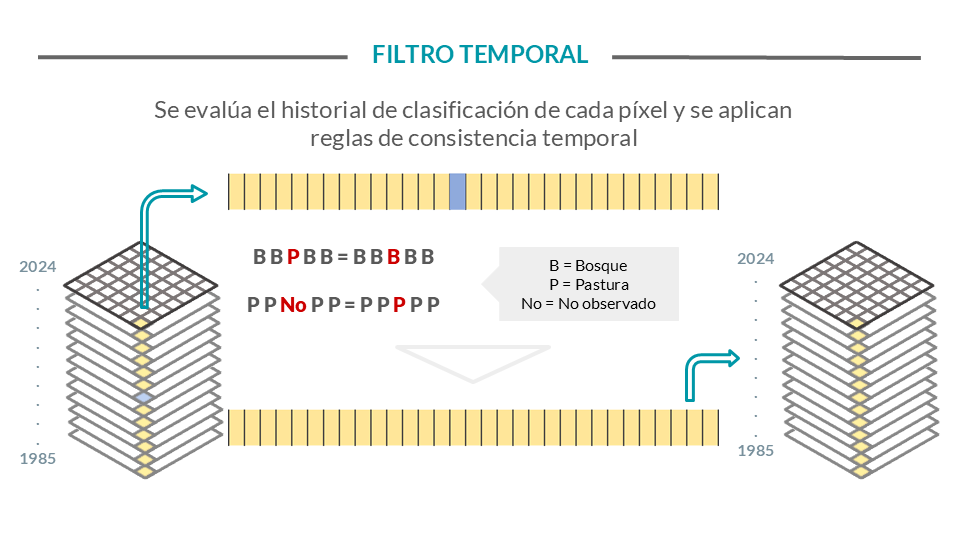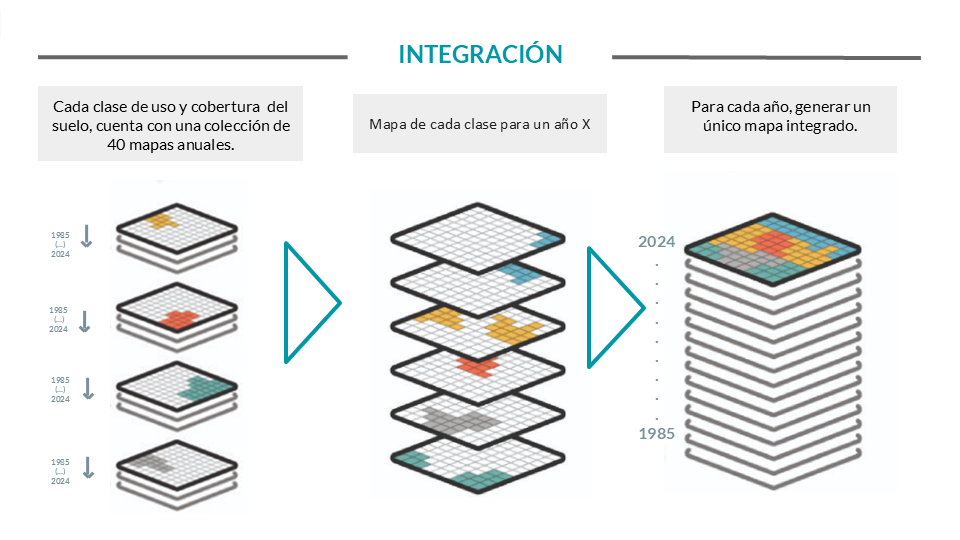GET TO KNOW THE STEPS OF THE MAPBIOMAS BOLIVIA METHODOLOGY
Here we detail step by step the methodology of MapBiomas Bolivia. For each class treated in the map, there are particularities and specific characteristics that can be consulted in detail in the . ATBD (Algorithm Theory Base Document).
Access full methodology - ATBD

Todo comienza con imágenes del satélite Landsat, con resolución de 30 metros, disponibles de forma gratuita en la plataforma Google Earth Engine y con una serie temporal de 40 años. Se construyeron 5.720 mosaicos en todo el límite nacional, cada uno con decenas de millones de píxeles en total. Estos píxeles son las unidades de trabajo de MapBiomas. Las imágenes pueden contener nubes, bruma y otras condiciones que pueden afectar su calidad. Para producir una imagen limpia se seleccionan los píxeles despejados de las imágenes disponibles para el período seleccionado. Para cada uno de estos píxeles se extraen métricas que explican el comportamiento del píxel en ese año. Esto se hace con cada una de las 7 bandas espectrales del satélite, así como con las fracciones e índices espectrales calculados. Por ejemplo, para la Banda 1 se recoge la mediana de los valores de la banda en el período, el valor máximo, el valor mínimo en el año y la amplitud de variación. Al final, cada píxel durante un año lleva hasta 156 capas de información.

For each year, a mosaic covering the entire country is created, representing the behavior of each pixel through 156 metrics or layers of information. This set of mosaics is saved as a data collection within the Google Earth Engine platform. These mosaics are used in two main ways. First, as a source of parameters for the algorithm to classify the images (see next step). This mosaic is also used to generate the RGB composition that allows visualizing the background image on the MapBiomas platform. This composition is also used to collect training samples and evaluate accuracy through visual interpretation.

From the image mosaics, the land cover and land use map is developed (forest, non-forest natural, agriculture, pasture, non-vegetated area, water bodies, etc.). To do this, analysts at MapBiomas Bolivia use an automatic classifier called "random forest," which runs on Google's cloud processors. This system is based on machine learning: for each class to be classified, the algorithm is "trained" with samples of the targets to be classified. These samples are obtained through reference maps, generation of stable class maps from previous series of MapBiomas Bolivia, and direct collection of complementary samples through visual interpretation of Landsat images.

The spatial filter aims to increase the spatial consistency of the data by eliminating isolated or edge pixels. Rules of neighborhood are defined that can lead to a change in the classification of pixels. For example, a pixel that has fewer than two of its nine neighboring pixels in the same class will be reclassified to the predominant class in the neighborhood. The filter is applied to all classes and years of the collection.

Para reducir las inconsistencias temporales, en particular cambios en la cobertura o el uso que son imposibles o no están permitidos (por ejemplo: Bosque natural > No bosque > Bosque natural) y para corregir fallas debido al desbordamiento de nubes o falta de datos, se aplica un filtro temporal. Cada bioma, tema o región puede tener reglas de filtrado temporales específicas. En total en la Colección 3 se aplicaron 3 reglas. El filtro temporal se aplica a cada píxel analizando todos los años de la Colección (por ejemplo, la Colección 3 tiene 40 años).

In this step, the maps of each class are integrated into a single map that represents the land coverage and use of the entire territory for each year. Prevalence rules are applied: in this way, if the same pixel is classified into two different class maps, it is possible to define which one it belongs to in the final map. Prevalence rules may vary depending on the peculiarities of biomes, themes or regions. The integration is performed for each year in the series and generates an integrated map for each year, usually saved as a single ASSET with the number of annual layers for the analyzed period. The embedded map goes through one more spatial filter step to clean up any edges and loose pixels as a result of the embedding process.

To understand changes in land cover and land use, maps with class transitions between different pairs of selected years are produced. This allows for the analysis of changes in the territory and answers questions such as how much of the woody class converted to pasture from one year to another. Transition maps are generated pixel by pixel and, once completed, they are also subjected to a spatial filter to eliminate isolated or edge pixels. Transition matrices are constructed from these maps for different territorial divisions available on the MapBiomas Bolivia platform.

